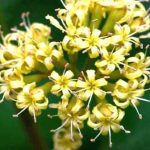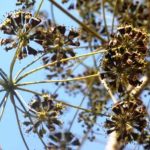TREE LIFE
AUGUST 1990
MASHONALAND CALENDAR
Saturday 4th August: Botanic Garden Walk. Park you car at the Herbarium where we will meet Tom Muller at 1045 hours for 1100 hours.
Sunday 19th August: The venue for this month’s outing is a little closer to Harare – about 30km. We will be visiting Trance and Pat Bragge on Balkiza Farm beyond Teviotdale, where a good variety of trees await inspection – easy walking and nice rocky outcrops along the edge of a dam which will provide ideal picnic spots for lunch.
Saturday 25th August: Explore with Mark the woodland near the corner of Harare Drive and Latimer Road in Greengrove. To get there, take the Mutare Road going east until you get to Harare Drive on the left. Go along Harare Drive for about 1.5 km. The junction with Latimer Road is on the left. Meet there at 1500 hours.
MATABELELAND CALENDAR
Sunday 5th August: we go to Ponderosa Farm, the home of Colin and Judy Martin, near Esigodini, on the Ncema River. We may also go to High Acres above the Upper Ncema Dam area. An all day outing. Bring lunch and chairs. Meet at Ascot Car Park at 0830 hours.
On Sunday 2nd September: we go to Cordon Park, Matopos, details later.
MATABELELAND NOTES
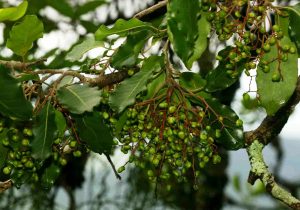
Apodytes dimidiata. Photo; Bart Wursten. Source: Flora of Zimbabwe
On Sunday July 1st we went to the Matopos, Efifi area. In an area noted for its many tree species, we only recorded some 66 species, because much of the time we stuck to the heights of the many whalebacks there and the trees thereon, including on Efifi itself. Also we found several problem trees.
Amongst others we found Albizia antunesiana, very purple for a change, A. tanganyicensis, the brown paper bark, Aloe excelsa, Apodytes dimidiata, several fine shiny specimens, Brachylaena rotundata, many Burkea africana, Cassia abbreviata, Combretum apiculatum, C. molle, Commiphora mollis, C. pyracanthoides, Croton gratissimus, Elephantorrhiza goetzei, Euclea divinorum, E. natalensis, fruiting heavily and E. racemosa, very shiny, Euphorbia cooperi, Faurea saligna, Ficus abutilon (abutilifolia), F. cordata, F. ingens, few, F. thonningii, Grewia monticola above and G. flavescens, below, Heteropyxis dehniae, Hexalobus monopetalus, Kirkia acuminata, Lannea discolor, Maytenus heterophylla subsp. puberula, the local subspecies, Maytenus senegalensis, flowering, Mimusops zeyheri, Ochna glauca, Olea europaea subsp. africana, Ozoroa insignis subsp. reticulata, Pavetta eylesii, Ptaeroxylon obliquum, sneezewood, Pterocarpus rotundifolius, widespread, Pterolobium stellatum, Rhus leptodictya, Schrebera alata, Strychnos cocculoides, S. madagascariensis, S. matopensis, S. spinosa, Tarchonanthus camphorates, Tarenna neurophylla, T. zimbabwensis, Tetradenia brevispicata, Vepris reflexa, Ziziphus mucronata.
After lunch we went on to the Lower Outspan to meet the Young Ornithologists, as arranged. There we played Tree Bingo. The Tree Bingo went very well. The children entered into the spirit of the game, which had heightened interest for them as there were a number of excellent talks by our members about various species on the Bingo card. Many of the lecturers were school teachers and it was of some interest to compare their methods. Of course the children were getting the benefit of professionals.
Tree Bingo requires an area with many species in a fairly confined area, and the Lower Outspan certainly provides this.
-C. Sykes
MATOPOS ON 1ST JULY – CONTINUED
Those of us who puffed our way up Efifi kopje after tea time were rewarded by the wonderful sight of the pendulum display flights of a pair of Black Eagles (which is also beautifully illustrated in Val Gargett’s new book) –a once in a life time experience.
But we were back to trees after lunch on meeting up with the Young Ornithologists’ Club members. I would like to thank our members for their interest and enthusiasm in giving the tree talks during the ‘Bingo’ sessions. It was fascinating to note the differing performances by the teachers – Ian, Joy and Thora, the semi teacher, Margaret and the non teachers – Peta and Dennis. It made for a varied programme and it was amazing that the children were still interested after about one and a half hours.
So much so that we received the following letter from Sheila Hederman, YOC Leader:
“Thank you so much for the delightful Sunday we all spent with the members of the Matabeleland branch of the Tree Society. It really was the finest day out that we have enjoyed for a very long time. The children were delighted with the idea of Bingo and the interesting talks that some of your members gave them, not to say all the help they got”.
Editor’s note: Ken Blake is a keen motorist and so similarities in car and tree names spring readily to his mind when he is talking trees.
On one outing he likened the specific name of Rhus lancea to the Lancia car, now seldom seen although very posh in its day.
That same evening he was phoned by a member who wanted to be reminded of the tree name that rhymed with Porsche.
-Ken Blake
TULI P.S.
As a minor postscript to the visit to Tuli in May, Bob Drummond kindly named specimens collected from two shrubs which I think at the time were not named. The first was a shrub on the track, not very far downstream from the camp. There was a colony of plants in green leaf all of which had been browsed to the same level. No flowers were seen but there were a number of green calyces looking like Chinese hats. This was Acalypha pubiflora (EUPHORBIACEAE).
The second shrub was a grey, strongly aromatic plant, forming quite large colonies, a little further downstream by the track. After some searching, some flowers were found to show that it was a member of the Compositae, the overall impression being that of a Vernonia. It was in fact Pluchea leubnitziae (formerly known under the somewhat startling name of Pechuel-Loeschea leubnitziae!)
M.A. Hyde
BOTANIC GARDEN WALK – SATURDAY 7TH JULY
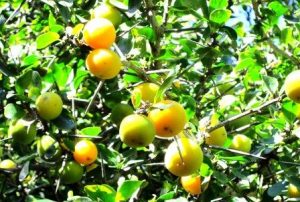
Dovyalis caffra. Photo: Rob Barrett. Source: Flora of Zimbabwe
The morning began with a query as to the identity of a spiny tree with shiny green leaves in the Middle veld Section. A few weeks earlier there had been yellow fruit on it (looking like yellow plums, but with several large seeds instead of a single stone). This was in fact Dovyalis caffra, a tree that is not that common but grows in the Masvingo to Bulawayo area and is found around Great Zimbabwe. The leaves are entire and are clustered on dwarf side shoots. We then went on to look at others in the FLACOURTIACEAE.
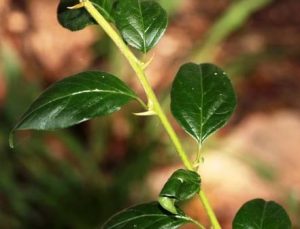
Dovyalis zeyheri. Photo: Bart Wursten. Source: Flora of Zimbabwe
Dovyalis zeyheri was growing nearby. This has fewer, more slender spines and leaves with slightly scalloped margins. The lateral veins are similar to those of D. caffra leaves with leaf miner tracks. We looked briefly at Flacourtia indica which can be so variable with smooth or furry leaves and spines or no spines. Next came Scolopia zeyheri which has a leaf that is similar to that of D. zeyheri but is much more leathery. These trees are often found on termite mounds, there is one opposite the B. S. Leon entrance in Monovale; and they often develop massive spines on the main stems. Still in the forest section, we then came to D. lucida. This is the glossy dovyalis of the Vumba and Chimanimani areas. The leaves are a dark green, very shiny and occasionally toothed.
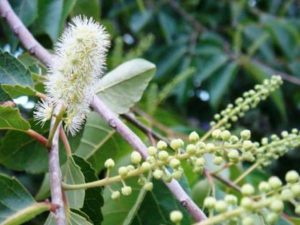
Bivinia jalbertii. Photo: Maureen Silva Jones. Source: Flora of Zimbabwe
Bivinia jalbertii is a distinctive tree with a ramrod straight trunk and horizontal branches, a possible replacement for gum poles as the wood is borer resistant. However it is a rare tree, only found in the Ngundu Halt area. Homalium dentatum , a dry forest tree, has almost circular leaves which are slightly furry on the underside and the same horizontal branches.
Our last three trees were in the Highveld forest sector around the Anthocleista trees. Rawsonia lucida is a very common tree in the Vumba. In April the trees there were covered in miniature ‘fried egg’ flowers, they look like small versions of the Oncoba flower. The leaves are leathery, dark glossy green and have spine tipped teeth around the margin. The Dovyalis macrocarpa that we looked at was a much eaten little tree, with slender spines. As the name suggests, its distinctive feature is the large, persistent calyx which surrounds the fruit.
Scolopia stolzii is an unarmed tree of low altitude forest margins. The leaves are slight serrated. The new flush is a brilliant red, making these trees stand out in the forest.
Our thanks to Tom for taking us around despite a pulled leg muscle.
-Tessa Ball
BALLY VAUGHN – 15TH JULY
It is unusual for Society members to be greeted by four baby elephant, but this was how our day started at Bally Vaughn Farm. A herd of sable and another of impala stood on a nearby granite outcrop, rather disdainful, I thought, as if the confrontation between somewhat over weight humans and well covered elephant was beneath their dignity. The flock of guinea fowl just went on pecking.
It is usual for Society members to be overwhelmed by the hospitality of their hosts, and today was no exception. Robin and Kathy McIntosh had laid on tea, and transport and a trail had been cleared to enable George Hall to lead our outing through a well treed portion of the Game Park.
The first thing that struck us was the number of large trees, especially Pericopsis angolensis (mwanga) that we came across. The writer is of the opinion that, had this observation been made a hundred years ago, it would have been met with rather puzzled looks. Is it not possible that the bush at that time consisted mainly of large trees. And that the demands of an expanding economy resulted in most of the large ones being felled?
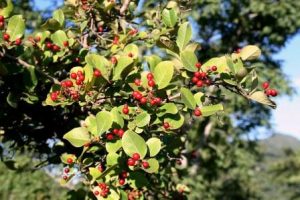
Psorospermum febrifugum. Photo: Mark Hyde. Source: Flora of Zimbabwe
Our walk took us along the foot of a granite kopje that was alive with Aloe chabaudii. A good variety of trees awaited us. We found Monotes engleri with its extra floral nectary at the base of the leaf blade and its hard fruit surrounded by five dry and brittle calyx lobes. There was Psorospermum febrifugum with a barely visible row of dark glandular dots along the edges of its opposite, decussate leaves. A handful of leaves in a hot bath has the reputation of reviving flagging physical and mental energies. It is also thought that a person wearing a piece of this plant in his hair becomes invisible to wild animals. What better place to test this theory than a game park with 27 species of animal in it (but do not chance your arm with the buffalo).
Pseudolachnostylis maprouneifolia (whew) was just starting to embellish the scene as its dying leaves took on a fiery red colour. This tree is known as the Duiker Berry or Kudu Berry depending on which side of the Limpopo it grows, and the fruit is very popular with buck. Pericopsis angolensis has already been mentioned. One of Gill Masterson’s many acute observations of the bush is that this tree always has a dead branch on it. Check it out. It is true. The timber of this is highly esteemed but hard won as it blunts both saws and axes very rapidly.
We were reminded that it was the middle of winter by two trees in particular – Cussonia arborea and Kirkia acuminata. The former’s stumpy branchlets, devoid of leaves, showed how it acquired the common name of Cabbage Tree. The latter, equally leafless, was identified by the fruit, a woody capsule that was still hanging on. The wood of this tree contains silica crystals which, as in the Mwanga, blunts axes and saw blades rapidly.
Thank you, Robin and Kathy, for allowing us to share your lovely part of the world this day.
-E.R.R.H.
TREES OF THE BIBLE
The Tree Society has been asked to produce leaflets for people to use when walking around the Botanic Gardens on their own. The first leaflet highlights trees of the Bible. Many people who have little interest in botany have shown great interest in biblical trees. Do not attempt the whole walk at once, when you begin to loose concentration stop and carry on again some other day. I would appreciate feedback on these notes as I hope to improve them before they are printed.
LET US BEGIN AT THE LAKE :
Enter the Gardens at the main car park and from the far left hand corner we can make our way to the edge of the lake where we have a wide view. Across the water and well over to the left is a park bench. To the right and slightly closer is a tall rounded tree with 8 main trunks that may appear yellowish as the bark peals off in small yellow flakes. This is a sycamore tree (Ficus sycomorus), just like the one that Zacaeus climbed in Jericho in order to get a good view of Jesus (Luke 19: 1-4). Another fine example grows further to the right but is party obscured by dense foliage. Look even further to the right and notice the clump of palm trees. These are wild date palms that grow along many of the lowveld rivers around Zimbabwe. They belong to the genus Phoenix, a name which is derived from Greek and reminds us of the land of palms’ north east of Israel called Phoenicia. Jesus visited the cities of Tyre and Sidon in Phoenicia, it was here that he cured a demonised girl (Matthew 15:21-28). If you move close to the lake you will see the beginning of a long strip of grass that stretches off to the right of the palms. On the left hand side of this trip you may be able to see the yellow trunks of the fever trees. We will walk past these trees later, but first we want to wander clock wise around the lake to examine the sycamore.
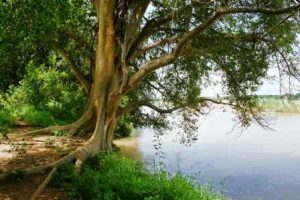
Ficus sycomorus. Photo: Bart Wursten. Source: Flora of Zimbabwe
Check that you have the correct trees by feeling the top of the leaf which should have stiff hairs that feel abrasive. The word sycamore literally means fig mulberry and refers to the fact this is a fig tree with leaves like that of a mulberry. You may be fortunate enough to see the figs on the special fruiting branches that grow out from the trunk and main branches. The leaves on both the sycamore and the mulberry have wavy edges and each leaf has three large veins that emerge from the base. They both contain copious sap that is inclined to be milky. Sycomores (spelt with an o) are not related to the sycamores of Britain and America, these are a type of maple.
Figs are pollinated by highly specialized stingless wasps. Many other stingless wasps, all the size of ants, are associated with figs. If you look carefully you may be able to watch these wasps laying eggs on the figs, if the figs are nearly ripe open them up to see if there are any wasps inside. It has been stated that the wasps which pollinate this particular fig tree do not survive the cold winters in Israel, if this is so then the sycamore that Zachaeus climbed would not have produced fertile seeds. In this case it is suggested that all specimens were planted from truncheons which were originally introduced from north Africa. The figs can be eaten, but in order to hasten the ripening the ancient Egyptians used to make a hole in the fruit. Gashed figs have been found in the pharaohs’’ tombs. It has been suggested that when Amos claimed that his original profession was to gather sycamore figs (Amos 7:27) this would have included gashing them a week or so before their harvest. Sycamores were particularly important as shade trees along roads as they are often in leaf when other trees are bare. Just like these fine specimens, many individuals have large low branches, this would have made it easy for a short person like Zachaeus to climb them.
In biblical times sycamores were particularly common in the lowveld (Shephelah) between Jerusalem and the coast (1 Kings 10:27). These trees were considered valuable enough for King David to appoint an administrative chief to care for them (1 Chronicles 27:28). In Zimbabwe the sycamore grows around Harare but just like in Shephelah it is much more common in the low veld particularly alongside the larger rivers.
The timber from the sycamore is soft and inferior to cedar wood (Isaiah 9 10), but it was used in building, the Egyptians made cases for their mummies from sycamore wood and these cases are still in good condition today. The death of many sycamores by hair during the ten plagues was considered important enough to be mentioned later (Psalms 78:47).
THE DATE PALM
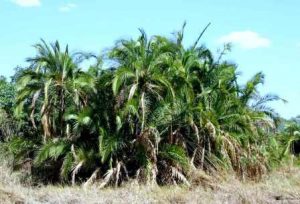
Phoenix reclinata. Photo: Bart Wursten. Source: Flora of Zimbabwe
Wander over to the cluster of wild date palms and examine the leaves. The leaflets on a palm leaf are either arranged like a fan (palmate) or a feather (pinnate). To check this compare the pinnate leaves of the date palm with the palmate leaves on the small ilala palms nearby. If you look at an individual leaflet you will see that it is folded along the centre, in some palms the leaflets fold upwards and so resemble gutters, in others the leaflets fold downwards and resemble roofs. Whenever you find a palm with gutter like leaflets arranged like a feather you can be sure that it is a type of date palm and will be called Phoenix. These wild dates (Phoenix reclinata) are common along the larger rivers around Zimbabwe. They often grow in clusters with some trunks leaning (or reclining) well out over the water. The fruits are small and not very tasty, although they are often eaten by children. Soaking the almost ripe fruit in water overnight is said to make them more palatable. The palm that produced the real date is Phoenix dactylifera which is not indigenous to Zimbabwe but is planted in the economic section of the Botanic Garden. Let us make our way past the fever trees and down the strip of lawn which we saw from the other side of the lake.
-Kim Damstra To be continued
NYARUPINDA CATCHMENT
It has not been really cold yet but the bush is drying quickly now and underfoot there is a crisp carpet of newly fallen leaves.
Species of Allophylus, Diplorhynchus, Julbernardia and Zanha have added their golden tones to the predominantly green Miombo woodland. Scattered occurrence of Croton gratissimus, Combretum adenogonium, C. molle, Flacourtia indica, Faurea speciosa and Pseudolachnostylis maprouneifolia have now become focal points with their displays in all shades of orange red, crimson and bronze colours. In a secluded place where the Nyarupinda river flows between steep high gravelly banks Boscia salicifolia and Pleurostylia africana are all set about with the gregarious Aloe zebrine, Kalanchoe lanceolata and the compact yellow heads of Inula glomerata of which the basal leaves are almost as big as those of tobacco. Tall Cyperus flabelliformis grows thickly in the river bed and up the bank until it is crowded by Syzygium cordatum, Sesbania sesban and two species of ferns bearing fronds one metre long. This plant community is on the bank which has a South aspect. In the shallow soil higher up where the ground levels out is where Faurea saligna, Xerophyta sp. and Monotes glaber occur. Up here there is a diminutive sedge which is adapted to a dry habitat. It could be likened to a very miniature love grass (Eragrostis sp.). Its leaves are so fine that its sedgy edges cannot be distinguished. The name of this plant is Bulbostylis macro and it belongs to CYPDERACEAE and it grows where ever there is shallow gravelly soil
The suffrutex Thesium located here recently cannot be identified now because all the Herbarium specimens have been sent away for revision of their classification. Thesium belongs to the Sandalwood family SANTALACEAE, the members of which are root parasites. Characteristically these are green plants which grow in the soil and parasitize the roots of other plants to obtain water and dissolved salts. Thesium is easily overlooked amongst the grasses which are thought to be its host, as it has green wiry stems, small narrow leaves and inconspicuous flowers. It is related to the shrub Osyris lanceolata found by the Tree Society on Kilmacdaugh Estate on the Great Dyke in 1976. The romantic sounding Sandalwood tree is semi parasitic, is slow growing and needs 20 to 40 years to produce the heart wood which yields the oil. This tree is a native of Mysore in Southern India. Vetiver Grass has been in the news lately, its roots have an odour like Sandalwood and a valuable essential oil is distilled from them. If this tall grass grows successfully in Zimbabwe, it may become a dollar earner. Its domestic use as a fragrant screen to shade the verandah would be an expensive luxury.
The following dialogue occurred when we went to the Dyke on Africa Day. The average regular “Tree Walker” does not actually walk very far. Occasional participants look forward to some healthy exercise during the day and become frustrated because each tree takes so long. “It is like the Stations of the Cross”. ….”Who is cross?” “Lia is cross because we keep stopping”. We sympathised with Lia, silence ensured, time for inspiration perhaps; thought of meditating on fourteen trees and wondering about the wood of Christ’s Cross, what kind was it? Father Hugh Ross is confident that an answer will be found, be it verse or Biblical commentary, in the library at St. George’s College.
PROTEACEAE Atlas Newsletters are unlike any Botanical literature available in Zimbabwe. They began in December 1988 and appear four times a year. Bird Atlasing is compared with the atlasing of Proteaceae, the reader is introduced to a lot of new words and their meanings. Every Newsletter is excitingly illustrated in several different styles, there is something to interest everybody both young and old. A crossword appeared in June 1989 and quizzes are a regular feature as are up dates on everything to do with Atlassing. As this project progresses the Newsletters are likely to become more and more technical but this should not deter the aspiring Proteaphile because the editors, Pat and Tony Rebelo have a way of presenting things for those people with ‘small beetle brains’.
Early in July a community of Processionary moth caterpillars were on the bark of Rhus longipes in the garden. Curiosity made us touch one of them with a twig, instantly it pushed out a drop of yellow fluid and they all let go and fell to the ground. In an incredibly short time they vanished amongst the debris on the gravelly soil. We had witness a truly remarkable survival exercise. The community has not returned to that tree or been seen again.
NEW BLOOMS – Small sour plum Ximenia americana, is just opening some four petalled flowers, this seems to be all at the moment. Tomorrow’s ride to the area where Elephantorrhiza goetzei grows amongst granite boulders may reveal something of interest.
At the top of the ‘gomos’ on the south eastern margin of the catchment there is a species of Xerophyta which is different. It has grey green leaves bearing white short hairs and glistening long ones. These plants form large clumps in a very exposed position.
-Benadicta Graves
MANA MAGIC
How does one, in a few words, even begin to adequately describe the uniqueness of Mana Pools, its wild earthiness and striking contrasts; the peace that pervades one’s being as the quietness of the bush makes itself felt; or the sense of awe and caution when peering into the thick scrub and jesse bush, knowing that dangerous animals such as lion are more than likely concealed there and yet realising – as was so often reiterated in the film “The Gods must be crazy 11” they wont bother you if you do not bother them.
Entering this wonderful new world begins shortly after leaving the National Parks office at Marongora and making a scenic descent from the escarpment to the Zambezi Valley which, as the brochure advises, is a western extension of the Great Rift Valley. The first obvious feature of changing vegetation are the Baobabs, Adansonia digitata. Most of these fascinating trees had already lost their leaves and some were in full fruit, which dangled from their huge limbs like pale olive green pearls.
Then, suddenly after miles of jesse bush and Colophospermum mopane, one sees the magnificent groves of Faidherbia albida. under which the dwarfed elephant wander.
After we had reported to the tourist office at Nyamepi, we made our way to Vundu Camp, where we were to stay for the next six glorious days. Prettily situated on the banks of the Zambezi River, the camp consists of two dormitories, a kitchen, an open lounge/dining area, ablution block and braai place, very comfortable and convenient for the six of us. On the opposite bank of the river which is about 800 metres wide at this point, looms the Zambian escarpment, and it was lovely watching the sun setting over those hills.
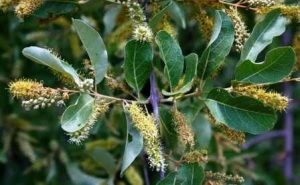
Combretum imberbe. Photo: Bart Wursten. Source: Flora of Zimbabwe
There were some rather interesting trees around our camp, one of the loveliest being a magnificent Tamarindus indica which was full of fruit which we tasted and found to be very acid, Cordyla africana, Lonchocarpus capassa, Trichilia emetica, Combretum imberbe and Kigelia africana, the sausage tree, the fruit of which the baboons were very protective of, as we often saw them hurry with large sausages under their arms!
Other trees that we saw during our many walks and game drives were the very large Ficus zambesiaca, Combretum mossambicense, Diospyros mespiliformis and Hyphaene petersiana. One thing that did cause us some concern is the fact that so many of the well established trees appear to be dying and there is no evidence of young trees to replace them.
This is very noticeable with the Faidherbia albida, which is suffering since the building of Lake Kariba. The river no longer floods over the plains therefore disrupting the important ecological cycle.
Mana’s main attraction is, of course, its wild life. Unfortunately a lot of the game was still up on the escarpment where food and water had not yet become scarce enough to force them back into the Valley. Although we distinctly heard the lion at night on several occasions, we did not manage to get a sighting. However we did see a fair amount of other animals including eland, kudu, zebra, buffalo, warthog, waterbuck, four species of mongoose, impala by the thousands, vervet monkey, baboon galore and plenty of elephant. Besides the lion at night we also heard the eerie whooping of hyena, the cry of a jackal and the din caused by a couple of honey badgers as they raided our rubbish bins. And, just to add to the homeliness of Vundu a couple of hippo swam up and down the river just below our camp. It was such a delight to hear their gentle grunts periodically below our camp throughout the day and night. Most of our hippo sightings consisted of spotting a couple of tiny nostrils, eyes and ears briefly breaking surface and just as quickly disappearing again.
Those who are interested in the Rhino Survival Campaign will be interested to know that, although not seeing the animals themselves, we did see fresh rhino spoor on two occasions. It is good to know that they have not been completely poached out of Mana.
Mana also has quite a variety of birds. We saw over ninety species which included Racket tailed roller, White fronted plover, Lilian’s lovebird, White headed vulture, Gymnogene and we were lucky enough to see a Peregrine falcon go for a dove at considerable speed. And perhaps the loveliest of the all, because it is so Zambezi Valleyish, was the African Fish Eagle with its haunting call, the memory of which makes one yearn to return to Mana once the holiday is over.
And, as we sit here reminiscing, the hankering to return waxes stronger still. What a privilege it is to live in a country that affords us the opportunities to visit such nature spots. May we be ever aware of the responsibility we share in protecting and preserving our heritage.
-Debbie Speller and Peta Ditchburn
MUKUVISI WOODLAND NOTES
A problem met in writing a few paragraphs such as this essay is to decide what to leave out, even in a small nature reserve there is so much happening.
This month I start with Phyllanthus reticulatus which I have re found after some years. We often see and smell this tree at medium to low levels. Well we have one healthy specimen in fruit in Mukuvisi.
Is the colloquial verb ‘to twitch’ appropriate in reference to trees? Or, may it only apply to feathered beings? Whatever, I ‘twitched’ as I added this to my personal check list. This plant is almost the sole survivor of a plantation almost a decade old. Strangely, all the local indigenous trees put out at the same time have perished. Next to this one was a sturdy young Peltophorum africanum, loss of which is not serious, we have two flourishing groves of this species descended from old individuals. One of these groves is a very fine practical example of plant succession.
Peltophorum africanum along with Erythrina and the whole PROTEACEAE make good examples on a guided walk when we think about continental drift. When I was at school I recall being told that there was this nut .. Alfred Wegener, who believed in the drift theory. We were cautioned to avoid the folly of mentioning anything like that in an exam paper. Better still do not even think about it in polite company, for fear of being certified.
It had the same status in those days as ‘flying saucers’ later achieved. Ridicule was the least you deserved. And that reminds me that the Woodland, and a now long dead Uapaca concern one of the two remaining observations I have made on phenomena which might be extra terrestrial in origin.
One November I found a dead tree, nothing unusual in that, except in the manner of its demise. In full flush of spring growth, it had been struck dead with such a release of energy that the trunk had burst into flames. The furthermost leaves and twigs whilst not consumed by flames, had blackened and died as in an instant in time. There was a definite point of impact at about eye level, damaged twigs on nearby musasa trees indicated a kind of trajectory showing from whence direction this had come.
I telephoned the Met. Department. Without embellishment I explained the death of this tree. At first the official to whom I spoke believed I was making some kind of complaint. When I convinced him I was seeking knowledge, he carefully noted my remarks and declined an invitation to be guided to the scene. Seven days later I received a very pleasant telephone call, it told me that they had thought about what I had reported and considered that the cause was lightning.
Now come an average rainy season, we get a lot of trees struck by lightning and know what it looks like. Also, the seven days prior to my observation had been clear anti cyclone, not a trace of thunder activity.
In my own mind I am satisfied that this tree was killed by a speck of meteoric dust. Unfortunately I had not got a Geiger counter in my back pocket to check possible radiation levels.
-G.Hall
BLOSSOM TIME
It will not be long before the bush comes alive again with colour as the weather warm-up. Members may be interested in the following extracts from “A Field Guide to the Wild Flowers of the Witwatersrand and Pretoria Region” by Braam van Wyk and Sasa Malan. The colouring and pollination described applies to all blossom, of course. The Field Guide is strongly recommended to members interested in herbs and shrubs as well as trees – many of the plants described may be found in Zimbabwe.
WHITE OF WHITISH FLOWERS
White coloration in flowers is due mainly to multiple reflections of light by air spaces between colourless cells in the petals. It is a physical phenomenon (comparable to foaming water or snow) and no white pigments are involved. Many white flowers, however, contain a variety of flavonoid (yellowish) pigments which, to the human eye, may impart an ivory or cream coloration to the flower. These pigments absorb ultraviolet light which, although not perceptible to the human eye, is clearly visible to insects. To insects white flowers might, for example, appear blue green or yellow. White petals with a uniform reflection of light throughout the visible and near ultra violet spectrum have seldom been found. This suggests that, in the eyes of an insect, white coloured flowers are probably extremely rare.
White flowers are visited by large variety of insects, especially bees and moths, but also flies, butterflies and beetles. Regular white flowers with an exposed disc are often fly-pollinated. Flowers pollinated by hawk moths (Turrea sp. Gardinia sp.) are almost always white (sometimes with a yellow or pink tinge) and have abundant nectar in long narrow tubes. They lack nectar guides, emit a sweet heavy scent at night and often close during the day.
YELLOW OR CREAM FLOWERS
Most yellow flowers owe their coloration to the carotenoid (orange or yellow) and flavonoid (yellow) groups of pigments. Often present as droplets or in granular or crystalline form, carotanoids are enclosed in numerous discrete bodies called chromoplasts. Flavonoids are soluble in water and colour the cell sap.
Yellow flowers attract all the main groups of insect pollinators. Bees and some butterflies (particularly the nympholids) show a strong preference for this colour group. Flowers which attract bees are usually irregular and characterised by nectar, nectar guides and few stamens. Those pollinated by butterflies have a slight scent and their nectar is well hidden in narrow tubes and spurs. Ultra violet reflection is often found in yellow flowers. To insects yellow may appear purple, red-purple or red.
PINK TO RED OR RED-PURPLE FLOWERS
Colours of flowers in the range from pink to red to purple to blue usually result from the presence of anthocyanins, a group of pigments belonging to the same class of chemicals as the yellow favonoids. Anthocyanins dissolve in the cell sap and can vary, depending on the ph of the solution. If it is very acid, the colouring is most likely to be red, whereas if it is more alkaline, the pigment tends towards blue. Purple comes in many shades which fall between red and blue. Red flowers are most often associated with pollination by sunbirds (Erythrina spp) and certain butterflies, particularly the swallowtails and the whites. Bees and most other insect pollinators are red blind and in theory should not be attracted to pure red colours. However, in nature many red flowers are visited by bees which are attracted by the ultra violet light that the flowers reflect rather than by the red. In addition, red-purple and most red flowers contain a blue component and this is visible to bees. It has also been shown that bees can be trained to respond to red colours, even those of flowers which typically attract birds.
Birds have a colour vision very similar to that of humans except that they react less strongly to blue or violet and are more sensitive to red. They also resemble humans in that they are blind to ultra violet light. To most insects bright red flowers which do not reflect ultra violet might, for example, appear dull grey, while those reflecting ultra violet are likely to be perceived by them as blue.
BLUE OR BLUE PURPLE FLOWERS
Anthocyanins dissolved in the cell sp are responsible for the blue and blue purple colouring of the flower petals. The colour that they produce varies according to the ph of the sap, being red in an acid solution and blue in a more alkaline one.
Bees visit blue flowers more frequently than any other insect group, and irregular blue flowers in particular are nearly always bee pollinated. To bees blue and blue purple probably represent one single colour and may be perceived as green. Through the eyes of insects the green foliage of plants is believed to be a dull yellow grey, a neutral back ground against which the insect green flowers would contrast vividly.
DICK HICKS CHAIRMAN


